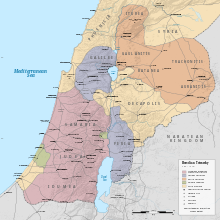
Back الربعية الهيرودية Arabic Herodovská tetrarchie Czech Herodianische Tetrarchie German Ηρώδεια Τετραρχία Greek Tetrarquía herodiana Spanish چهارسالاری هرودی Persian Tétrarchie d'Hérode French הטטררכיה ההרודיאנית HE Tetrarki Herodes ID 헤로데 사두정치 Korean
| Herodian tetrarchy | |||||||||||
|---|---|---|---|---|---|---|---|---|---|---|---|
| Tetrarchy of the Roman Empire | |||||||||||
| 4 BCE–44 CE | |||||||||||
 Territory under Herod Archelaus
Territory under Herod Antipas
Territory under Philip
Territory under Salome I
| |||||||||||
| Capital | Jerusalem (Herod Archelaus) Sepphoris later Tiberias (Herod Antipas) Caesarea Philippi (Philip) Jamnia (Salome I) | ||||||||||
| Government | |||||||||||
| King, Ethnarch, Tetrarch, Toparch | |||||||||||
• 4 BCE–6 CE | Herod Archelaus (as Ethnarch) | ||||||||||
• 4 BCE–39 CE | Herod Antipas (as Tetrarch) | ||||||||||
• 4 BCE–34 CE | Philip (as Tetrarch) | ||||||||||
• 4 BCE–10 CE | Salome I (as Toparch) | ||||||||||
• 37 CE–44 CE | Herod Agrippa I (as King) | ||||||||||
| Historical era | Augustan Age | ||||||||||
• Death of Herod the Great | 4 BCE | ||||||||||
| 6 CE | |||||||||||
| 39 CE | |||||||||||
• Territory of a province Judaea transferred to Herod Agrippa I's dominions | 41 CE | ||||||||||
• Death of Herod Agrippa I, his dominions annexed as a province Judaea | 44 CE | ||||||||||
| |||||||||||
The Herodian tetrarchy was a regional division of a client state of Rome, formed following the death of Herod the Great in 4 BCE. The latter's client kingdom was divided between his sister Salome I and his sons Herod Archelaus, Herod Antipas, and Philip.[1][2] Upon the deposition of Herod Archelaus in 6 CE, his territories were transformed into a Roman province.[3] With the death of Salome I in 10 CE, her domain was also incorporated into a province.
Other parts of the Herodian tetrarchy continued to function under Herodians. Philip ruled over territories north and east of the Jordan River until 34 CE. His domain was later incorporated into the Province of Syria. Herod Antipas ruled Galilee and Perea until 39 CE. The last notable Herodian ruler with some level of independence was King Herod Agrippa I. He was given the territory of Judea with its capital Jerusalem. With his death in 44 CE, the provincial status of Judea was restored for good.
Later Herodians, Herod of Chalcis, Aristobulus of Chalcis and Agrippa II, reigned over territories outside of Judea with the title of king but as Roman clients. The last of them, Agrippa II, died childless in c. 100 CE and thus all territories previously ruled by members of the Herodian dynasty were incorporated into the province of Syria.
- ^ Esposito, Gabriele (2023-06-30). The Army of the Early Roman Empire 30 BC–AD 180: History, Organization and Equipment. Pen and Sword Military. ISBN 978-1-5267-8742-2.
- ^ Queirós, José Maria Eça de (2022-01-14). The Falling Snow and Other Stories. CUA Press. ISBN 978-0-8132-3504-2.
- ^ H.H. Ben-Sasson, A History of the Jewish People, Harvard University Press, 1976, ISBN 0-674-39731-2, page 246: "When Archelaus was deposed from the ethnarchy in 6 CE, Judea proper, Samaria and Idumea were converted into a Roman province under the name Iudaea."